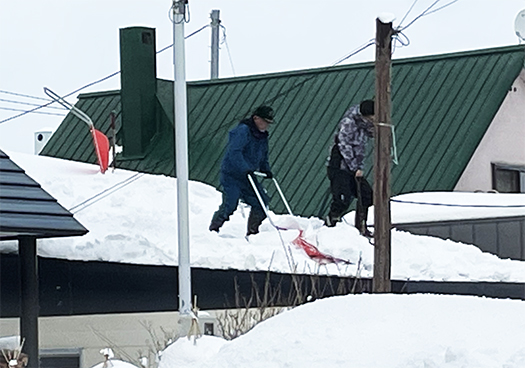
3月にようやく入って数日。いまのところ大雪はしばらく遠ざかっている。不気味な沈黙だけれど、さてこのまま、冬将軍様は春の到来におとなしく従われるのか、微妙な時期。
札幌管区気象台の発表では札幌市西区に3/4午前9時現在で積雪深は89cm。昨年が88cm、平年が80cmなので、やや多めに堆雪している。公共の除排雪の日程が先週末の予定と回覧板周知されていたけれど、わが家周辺にはそういった形跡は見られません。春の訪れをぼんやりと待っているような今日この頃であります。
ふと窓外を見たら、ご近所のキリスト教系の「幕屋」建物の屋根にうずたかく乗っていた雪を下ろすべく数人の人影が見られた。ママさんダンプで固くなっている雪の「岩盤」にヨイショッと裂け目を入れて、体重を乗せて雪を割って、屋根から滑り落とす作業。落下後の雪は除雪機で吹き飛ばしながら作業していた。
こういう光景はしかし北海道ではいまほとんど見られなくなっている。
それは屋根の作り方が急角度の落雪屋根か、そうでなければ「載せたまんま」のフラットルーフやダクトを通して融水として落とすスノーダクトなどの無落雪屋根が主流になっているから。
こちらは非住宅での集会施設ということで緩勾配の屋根。住宅では当然、屋根の雪をどうするかと言う問題は、北海道ではいちばんのポイントなのですが、集会場建築ということで信者さんの「人手」が確保できるということから、こういう屋根を造作したのでしょうか。
昭和中期生まれとしては、こういう光景にはある強いノスタルジーが掻き立てられて、作業を見つめながら、どうしてもその一挙手一投足に身体的共感が湧いてきてしまう。ついいっしょのタイミングで息をこらしたりしてしまう(笑)。60年前頃にはわたし自身も実家の屋根に上がって、同じような雪下ろし作業をしていたことが記憶復元してしまう。
当時の屋根形状はけっこうな急勾配であり、また屋根の高さも6-7mほどはあったように記憶している。
落ちたら「ヤバい」という緊張感の中で、スコップを振り下ろしていた。雪の積層に裂け目を入れて「パカッ」と割れて、屋根のトタン上を滑り降りていく様子を見ていた。あの瞬間は、作業していても一種の「快感」だった。
暖気の状況によっては「屋根なだれ」が発生してケガをする被害のローカルニュースも結構あったように記憶している。そういう走馬灯のような記憶が甦ってくるのですね。
こうした体験記憶の風化というのは北国住宅の進化を表してはいるのだけれど、ふと、こういう光景を見ているとまことに懐かしく、内奥から刺激される部分がある。そういうものも大切にしたいなと。
English version⬇
[Reunited with the culture of “snow removal” which has been abolished from Hokkaido.
Was it upper elementary school or junior high school? A scene that evokes memories of boyhood experiences. I surrendered myself for a moment to the memory of the experience imprinted on my body. The snow
We are finally a few days into March. So far, the heavy snow has stayed away for a while. It is a delicate time of year to see if General Winter will quietly follow the arrival of spring, although there is an eerie silence.
According to the Sapporo District Meteorological Observatory, the depth of snow in Sapporo’s Nishi Ward was 89 cm at 9:00 a.m. on March 4, which is slightly more than last year’s 88 cm and the normal year’s 80 cm. The public snow removal schedule was announced in a circular as scheduled for last weekend, but there is no such sign around our house. It is as if we are idly waiting for the coming of spring.
I looked out the window and saw a few people trying to get the snow off the roof of our neighbor’s Christian “tabernacle” building, which was covered in a thick layer of snow. With a mom-and-pop dump truck, they were breaking the hardened “bedrock” of the snow, breaking it open with their weight, and sliding it off the roof. The snow after falling was blown away with a snowplow.
This kind of scene, however, is rarely seen in Hokkaido anymore.
This is because most roofs are made with steep angles or otherwise have no snow falling, such as flat roofs that remain in place or snow ducts that melt water through ducts.
This is a non-residential gathering facility, so it has a gently pitched roof. In Hokkaido, the problem of how to deal with snow on roofs is the most important point for residential buildings, but I wonder if this kind of roof was built because it was a meeting place building and this kind of “manpower” could be secured.
As someone who was born in the mid-Showa period (mid-1989s), this kind of scene stirs a certain nostalgia in me, and as I gaze at the work, I can’t help but feel a physical sympathy for every move they make. I can’t help but recall that around 60 years ago, I myself went up on the roof of my parents’ house and did the same kind of snow removal work.
I remember that the roof of my parents’ house at that time had a very steep slope and was 6-7 meters high.
I was swinging the shovel down with a sense of tension that if it fell, I would be in trouble. I watched as it “popped” and cracked, ripping through the layers of snow, and slid down over the tin roofing. That moment was a kind of “pleasure” to work with.
I remember that there were quite a few local news reports of damage that caused injuries due to “roof avalanches” depending on the warming conditions. That kind of running memory comes back to me.
The fading of memories of such experiences is an indication of the evolution of housing in the north, but when I suddenly see such scenes, I feel really nostalgic, and there is a part of me that is stimulated from within. I want to cherish such things.
Posted on 3月 5th, 2024 by 三木 奎吾
Filed under: 日本社会・文化研究







コメントを投稿
「※誹謗中傷や、悪意のある書き込み、営利目的などのコメントを防ぐために、投稿された全てのコメントは一時的に保留されますのでご了承ください。」
You must be logged in to post a comment.